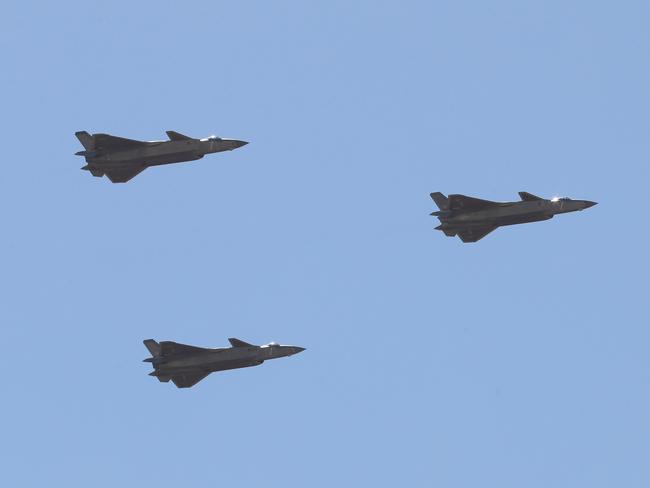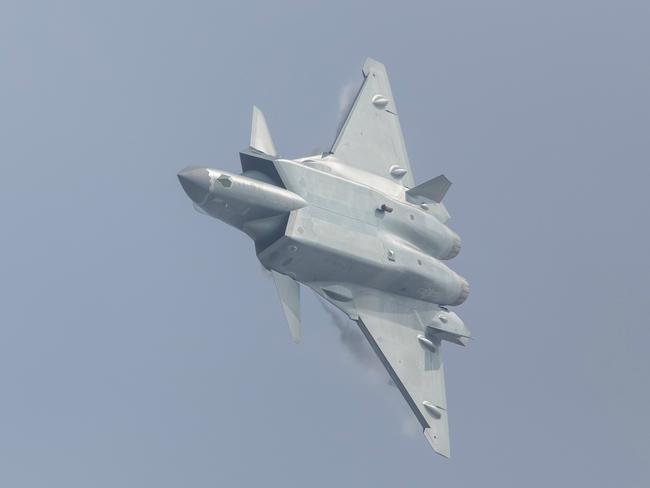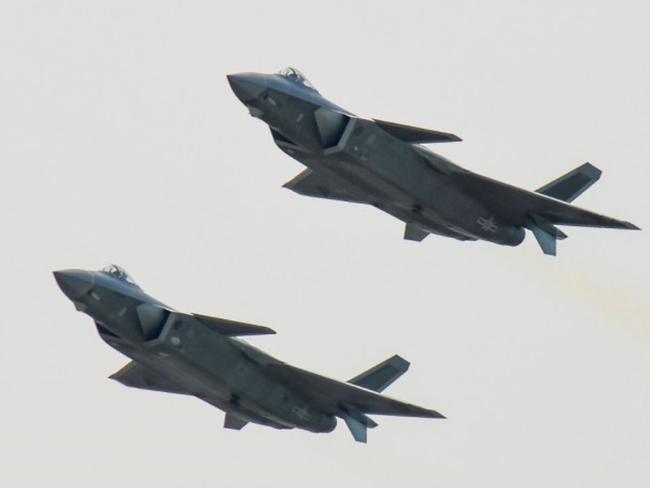With the J-20 stealth fighter in fully operational military service, China leaps ahead in Asian arms race
THE Chengdu J-20 stealth fighter — China’s most advanced combat jet — is ready to go. It’s a game-changer in the arms race.
CHINA’s made a significant step forward in its bid to equal — and eventually surpass — United States air superiority.
According to Beijing’s state media, its first stealth fighter has now entered fully operational, frontline service.
This puts it in second place.
Before now, only the United States has had a fully operational ‘fifth generation’ fighter.
And it’s easily the most capable aircraft deployed by any nation in its region — giving it a significant edge over the Japanese, Korean and Indian air forces.
China’s fourth-generation medium and long-range fighter jet, the J-20 stealth fighter has been officially commissioned into military service pic.twitter.com/TMyZWz4yR0
— People's Daily,China (@PDChina) October 19, 2017
Russia’s stealth fighter — the T-50 PAK-FA — appears to have stalled in its development. And the US ‘export’ stealth fighter, the F-35, continues to suffer protracted delays.
But the J-20 will now likely become a regular feature in the games of cat-and-mouse being played out over the South China and East China seas.
So what exactly is the J-20, and how does it compare with other modern combat aircraft?
According to Washington defence think-tank the Center for Strategic and International Studies (CSIS): “ Designed for enhanced stealth and maneuverability, the J-20 has the potential to provide China with a variety of previously unavailable air combat options and enhance its capability to project power.”
China declared the J-20 fully functional in May. Beijing’s State media has today said it is now operational and “officially commissioned into military service”, releasing a promotional video boasting of its capabilities as it celebrates the 19th National Congress of the Communist Party of China.

OUT OF THE BLUE
The Chengdu J-20 is not only China’s first operational stealth fighter. It’s one of its first fully indigenous combat jet designs.
Its appearance in 2011 stunned the military aviation world.
Earlier aircraft either owed much of their design to Russian sources, or were direct copies.
That China was able to advance so far, so fast, in its quest to attain “fifth generation” stealth fighter capability seemed virtually impossible.
But it was done. And now it’s operational.
The multi-role J-20 offers the People’s Liberation Army Air Force the ability to penetrate defended airspace to deliver its payload of weapons.
It also allows the fighter to range deep over the Pacific — unseen — to intercept the radar and refuelling aircraft so vital to the tactics of its contemporaries.
It can do these things because it appears to be a true “fifth generation” aircraft design.
It offers key modern features including stealth, advanced digital avionics and supersonic cruising speeds.
“The J-20 is the first Chinese aircraft to fit this description, and it may serve as a critical asset for both the air force and the navy,” the CSIS report reads.

WHAT IS THE J-20
A CSIS analysis of China’s large (20.5m long) stealth fighter shows it to be — at least on paper — a true competitor to the United States’ older F-22 Raptor stealth fighter.
It also appears to be possibly somewhat superior to the F-35 Lighting II strike fighter (which, despite its protracted development, still is not in truly operational service).
The extent of such performance, however, is yet to be tested. Exactly how effective is its stealth design? What is the actual performance and reliability of its engines?
These questions are yet to be answered.
But a look at its shape and configuration offers some clues.
The J-20 is powered by two jet engines, like the F-22 but not the F-35. This gives it both extra power as well as the ability to survive an engine failure.
China's 4th-gen supersonic stealth fighter J-20 roared overhead at the #PLA90 military parade pic.twitter.com/y7GG719PvX
— People's Daily,China (@PDChina) July 30, 2017
Unlike the F-22, these are set well back in the airframe.
This leaves ample space within the aircraft’s body for three large internal weapon bays — vital for stealth aircraft to remain invisible while carrying weapons. Two of the bays are smaller, capable of carrying air-to-air missiles. The larger third bay can hide heavier ant-ship or air-to-surface missiles and bombs.
The F-35, and to a lesser extent the F-22, have only small interior bays — meaning they must either go into combat with only a limited number of missiles, or give up much of their stealth advantage when carrying extra or larger weapons under their wings.
And like the F-35’s much-touted ‘advantage’, it appears to have full 360 degree infra-red/electro-optic detection systems allowing the pilot to look in any direction and “see” what is there.
But the J-20s stealth appears to be limited.
Analysts argue that the fighter appears to have only its front profile optimised for a low radar reflection signature. From the sides and rear, it is likely to look larger.
But to anything less than the most modern radar and infra-red sensors, it is still likely to be very hard to “see”.

WHAT DOES THIS MEAN
The J-20 is an “advanced aircraft to improve its regional power projection capabilities and to strengthen its ability to strike regional air bases and facilities ... The PLAAF ... views (this) technology as a core capability in its transformation from a predominantly territorial air force to one capable of conducting both offensive and defensive operations.”
That is, at least, the opinion of the US Department of Defence.
The aircraft’s size, range, payload — and stealth — is what makes this possible.
It is suggested the J-20s radar profile would make it an invisible interceptor — dashing out unseen to shoot down opposing aircraft.
But it would be another matter against ships, such as the US Navy’s carrier strike groups. The J-20 would possibly be able to dash into strike range largely unseen before unleashing its unseen missiles.
This is a nightmare scenario for the United States Air Force and Navy, both of which rely heavily on extensive support from its limited fleet of tankers and radar aircraft to enable its aircraft to reach their targets. And US aircraft carriers must already sail dangerously close to hostile shores for their aircraft to be effective.
But the J-20 would likely have only a limited ability to penetrate deep within hostile territory, before sensors detect its vulnerable sides and rear.
“Many details regarding the J-20 remain unknown,” the CSIS report observes. “Based on observed serial numbers and the recent unveiling of two J-20s at the Zhuhai Air Show in November 2016, at least eleven J-20s may have been produced. This number may suggest that the J-20 has now entered low-rate initial production (LRIP), the small-quantity testing phase prior to mass production.”





